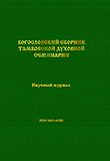The role of belief and faith in cognitive activity
Keywords:
God, faith, Holy Scripture, cognitive activity, natural sciences, general scientific picture of the world, epistemological and ideological principles of science, Orthodox worldview, true science, Ivan Panin.Abstract
History shows how often it is concluded that natural sciences are a stronghold of atheism. This is one of the main arguments of those who oppose the introduction of spiritual and moral subjects into the school curriculum. At the end of the 20th century, attempts were made to supplement the existing general scientific picture of the world with a new physical theory based on a religious worldview, which enriches the epistemological and ideological principles of the philosophical foundations of science and leads to its integration with religion. The author comes to the conclusion that the Orthodox worldview and true science are two channels that naturally lead to the knowledge and glorification of the Creator. Religion deals with the spiritual world and faith, science - with the material world and knowledge. The essence of true faith is extremely clearly expressed in the Orthodox "Symbol of Faith", which is from the Lord God, therefore, absolutely true and unchangeable. The essence of true knowledge is expressed by a set of corresponding physical concepts, that is, a paradigm, which is accepted by people on faith as a postulate, therefore, it is not absolutely true and necessarily changes over time. Misunderstandings, prejudices and antagonism arise when the transient “faith” (paradigm) of scientists is confused with the enduring faith of religion, which leads to confusions such as the centuries-old Catholic ban on the Earth revolving around the Sun. In order for humanity not to perish, a universal conversion of scientists to moral values in their cognitive activity is required. The Lord God addressed the world back in the middle of the 20th century through the discovery of Ivan Panin (in which the truth of the Holy Scripture is mathematically proven, and therefore the existence of the Creator). But this appeal was never heard by many scientists. The Holy Scripture of the New Testament says: “And this gospel of the kingdom will be preached in all the world for a witness unto all nations: and then shall the end come.” According to the Institute for Bible Translation, in Stockholm, by 1986, the Holy Scriptures had been translated into 1848 languages, and only about 2% of the world's population did not have a single book of it in their language. Now it is being translated into more than a thousand "small" languages, even if they are spoken by only a few thousand, hundreds or dozens of people. As we see, the entire Universe is just a stone's throw away, and our Lord Jesus Christ said: "Heaven and earth will pass away, but My words will not pass away."
Downloads
References
1. См.: Баранцев Р.Г. Синергетика в современном естествознании. М., 2003.
2. Мф. 15, 22-28.
3. Иоанн Дамаскин, прп. Точное изложение Православной Веры. М., 2003.
4. Феофан Затворник, свт. Письма к разным лицам о разных предметах веры и жизни. Репринт. изд. М., 1995.
5. Степанов В.М. Символ Веры в естественных науках. Навстречу 2000-летию христианства: Материалы конференции (10 фев. 1999 г.). Новгород, 1999.
6. Вейник А. Термодинамика реальных процессов. Минск, 1991.
7. Мф. 24, 14.
8. Лк. 21, 33.
REFERENCES
1. Sm.: Barancev R.G. Sinergetika v sovremennom estestvoznanii. M., 2003.
2. Mf. 15, 22-28.
3. Ioann Damaskin, prp. Tochnoe izlozhenie Pravoslavnoj Very. M., 2003.
4. Feofan Zatvornik, svt. Pis'ma k raznym licam o raznyh predmetah very i zhizni. Reprint. izd. M., 1995.
5. Stepanov V.M. Simvol Very v estestvennyh naukah. Navstrechu 2000-letiyu hristianstva: Materialy konferencii (10 fev. 1999 g.). Novgorod, 1999.
6. Vejnik A. Termodinamika real'nyh processov. Minsk, 1991.
7. Mf. 24, 14.
8. Lk. 21, 33.
Downloads
Published
License
Copyright (c) 2025 Theological Collection of Tambov Theological Seminary

This work is licensed under a Creative Commons Attribution-ShareAlike 4.0 International License.

